Digital Frontiers: Unveiling the Impact of Multinational Upgrades on Local Labor Markets

On March 9, 2023, the Anchor 4POINT0 webinar featured Tazia R. Khushboo and Professor Alexander Whalley from the University of Calgary, along with their industry partner Huju Liu from Statistics Canada.
In this session, Tazia R. Khushboo took the lead in presenting significant findings from their research on the impact of multinational digital firms on the local innovation ecosystem in Canada.
By Nicolas Sacchetti
From the outset, amid a global decline in research productivity, Professor Whalley emphasized the need for innovative approaches, advocating for the acquisition of better data and the implementation of new measurement methods. This project is specifically aimed at achieving these goals.
The research further explores how multinational digital firms affect the local ecosystem by examining the integration of AI technologies into workflows and their implications for the labor market. Professor Whalley highlighted the urgent need to understand how these technologies modify job types, influence worker earnings, and impact overall job dynamics. Although current evidence primarily concerns the effects of automation on lower-skilled workers, the ramifications of AI on higher-skilled workers remain largely unexplored and are marked by significant uncertainty.
To delve deeper into these issues, the research team is utilizing a distinctive matched employer-employee dataset provided by Statistics Canada, augmented with additional data on storage capacities. This collaborative initiative aims to shed light on the preliminary effects of AI technologies on the labor market.
Tazia R. Khushboo opened her presentation by emphasizing the critical importance of new digital technologies for firms. She noted that these technologies enhance efficiency through process automation, enable the use of data to generate customer insights, and help cater to individual customer needs and wants. These advancements ultimately assist firms in accessing new markets and boosting their productivity and profitability.
Post-Pandemic Digital Era
However, in the Canadian survey conducted in 2022 by StatCan (https://doi.org/10.25318/3310048701-eng), the results show a low score of 21.90% of firms planning to adopt new or additional digital technologies over the next 12 months. These firms are mainly in sectors such as information and cultural industries (42%), professional, scientific, and technical services (37.4%), finance and insurance (33.7%), wholesale trade (31.6%), and manufacturing (27%).
According to Khushboo, 57.2% of respondents are not planning to adopt new or additional tech over the next 12 months. To which a majority of 64.3% not planning upgrading consider it not relevant to the business. Construction – Transportation – Food services – Agriculture, forestry, fishing and hunting – and Real estate to be the Top 5 thinking digitech’s not relevant to them.

AI
Rapid advances in the application of AI across industries are likely to change businesses’ perception on relevance of digital technologies. However, utilization of AI is expending in many of these sectors, explains the scientist : “ For instance, if you look at the construction industry, firms can benefit from risk mitigation solutions, project planning, and building information modeling.”
She also mentioned the potential near future of driverless vehicles, the digital farming solutions used in Singapore – where vertical farming is part of the strategy to secure its food future, smart room technologies embedded with AI in hotels like robot arm providing automated luggage storage or self-service check-in, etc.

Yobot Luggage Robot at Yotel NY

Vertical Farming
Challenges in Adopting New Tech
“The most common response across firms on the challenges to adopt newer tech is the hiring of digital workers,” says Khushboo. She adds that data on Skill Requirement and Skill Shortage Across Industries (2019) back up such a response. Highlighting the skills shortage in jobs that require more digital technology.
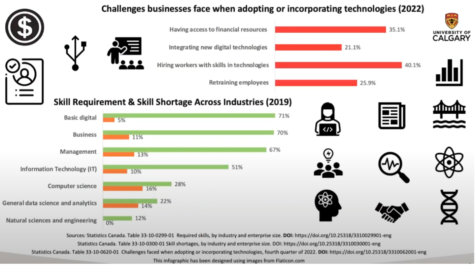
“This begs the question how technological upgrading is affecting outcomes for workers with different skill sets in the Canadian labor market.”
– Tazia R. Khushboo
Research Questions
By examining the case of multinationals operating in Canada, the researchers aim to understand how the upgrading of digital technologies by multinational firms affects the employment and wages of workers with various skills and specializations in the local labor market.
They are also interested in understanding how the decision by multinationals to digitally upgrade affects local Canadian firms: Are there any spillover effects from multinationals’ adoption of digital technologies on local Canadian firms? “While our focus is on multinationals, our estimation strategy will clarify these aspects,” says the scientist.
Wage Impact: Digital Skills Demand
Tazia R. Khushboo highlights two key motivations for the study. The first involves competing theories about the impact of multinational firms’ increased use of digital technology on the local ecosystem. One scenario suggests that as these firms ramp up their digital capabilities, they may compete with local businesses for skilled workers, thereby driving up wages and increasing the costs of digital adoption for local firms. This could discourage these smaller firms from embracing digital technologies.
The second motivation is to empirically determine which scenario applies to the Canadian context. Khushboo explains that multinationals often invest significantly in training digital workers. As these firms expand their technological capacity, the local labor market might experience an increase in available digital workers, potentially reducing wage demands. This could enable local firms to afford these workers and increase their digital integration. The study aims to test which of these outcomes prevails in Canada.
Tracing Tech Upgrades and Productivity
The productivity of firms, their employment levels, and the extent of digital technology integration may be interconnected, making it challenging to discern whether increased productivity leads to technological upgrades or if it’s the other way around. The researchers are particularly interested in how technological upgrades influence productivity and the subsequent effects on firms and workers. Khushboo emphasizes the crucial role of data from multinational firms in this investigation. To isolate the impact of digital technologies, the team will seek exogenous variables – specific instruments that affect how Canadian affiliates of multinationals upgrade their technologies. This approach aims to clarify the outcomes for firms and workers as technological enhancements are implemented.
Data Sources

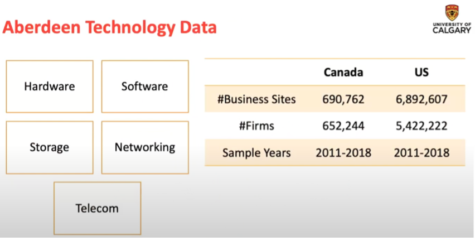
The researchers will be looking at three data sources spanning from 2011 to 2018. The Aberdeen Technology Data surveys pinpoint business locations that are potential candidates for future IT purchases. Tazia R. Khushboo describes it as a vast dataset encompassing all industries and firms of all sizes. The respondents to the surveys are IT professionals who possess in-depth knowledge of the technology used at their respective locations. To ensure the data remains current, trained research assistants conduct the interviews monthly.
The researchers have access to highly detailed and granular data at the business establishment level. Khushboo notes that these technology measures are comparable across countries, enabling valid international comparisons.
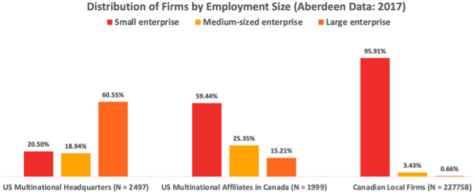
Khushboo has categorized the firms in the Aberdeen sample into three types: US Multinational HQ includes all US firms that own affiliate firms in Canada; US Multinational Affiliates in Canada comprises all affiliate firms of the US multinationals operating in Canada; and Canadian Local Firms refer to firms that operate within Canada and are owned by Canadians.
Khushboo notes that the Aberdeen Data (2017) has been selected for visual simplicity. Regarding the Distribution of Firms by Employment Size, small enterprises are defined as having 1 to 99 employees; medium enterprises, 100 to 499 employees; and large enterprises, 500 or more.
Inviting us to look at the graphic, Khushboo points out that 60.55% of US Multinationals are classified as very large enterprises. For US Multinational Affiliates in Canada, 61.53% are small enterprises. As for Canadian Local Firms, 95.91% are small firms.
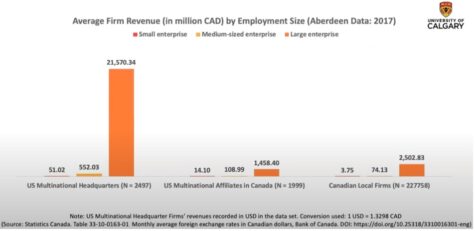
From the Aberdeen Data (2017), researchers also have access to revenues earned at the business establishment level.
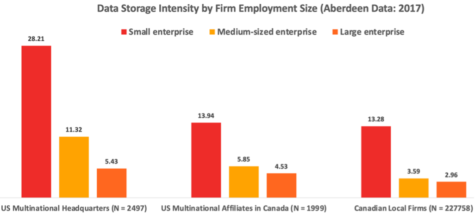
Storage Capacity
Here, “intensity” refers to the amount of technology a firm employs per worker. According to Khushboo, this metric provides insight into the relationship between the technology used and the number of workers at a firm. Technology intensity, specifically data storage, is measured in terabytes of data capacity per employee. “The data suggest that as firms expand their workforce, the increase in technology employed at the firm level does not necessarily keep pace,” explains the scientist.
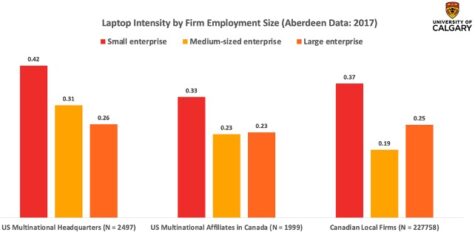
Worker-to-laptop Ratio
On the chart, US Multinational HQs show small enterprises with about 4 workers per laptop, medium ones with 3, and large ones with over 2. US Multinational Affiliates in Canada have small enterprises with about 3 workers per laptop, and medium to large enterprises with 2. Canadian Local Firms have nearly 4 workers per laptop in small enterprises, about 2 in medium, and over 2 in large ones. “We find that for Canadian Local Firms, laptop intensity is highest in small enterprises,” notes the analysis.

Top Canadian Sectors by Data Storage Intensity

“We selected the top Canadian sectors from the North American Industry Classification System (NAISCS) based on tech intensity,” says Khushboo. This graph illustrates the data storage capacity per worker and highlights that the Professional, Scientific, and Technical Services sector employs the most data storage per employee. This includes fields such as scientific R&D services, architectural engineering, and accounting and legal services.
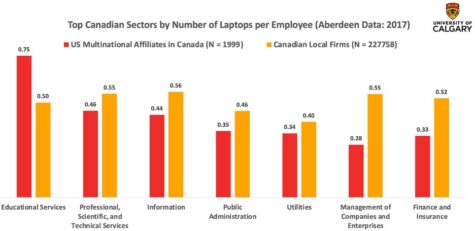
Top Canadian Sectors by Number of Laptop per Employee
The Educational Services sector encompasses specialized schools, tutoring services, professional training, online platforms, and other educational support services beyond traditional elementary to university institutions. Tazia R. Khushboo further explains, ‘For those wondering why Public Administration appears here among US Multinational Affiliates in Canada and why it exhibits high tech intensity, it’s important to note that this subsector includes establishments of foreign governments in Canada that are primarily engaged in governmental service activities, such as consular, diplomatic, and litigation services.”
“We can see that Multinational HQs consistently lead in adopting newer technologies like data storage, while in more established technologies such as laptops, Affiliates and Local Firms can also be at the forefront,” Khushboo emphasizes.
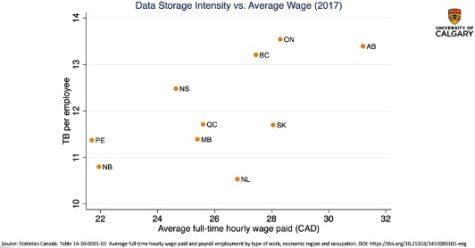
Data Storage Intensity vs. Average Wage (Aberdeen, 2017)
Here, the researchers are examining whether a relationship exists between data storage intensity and wages at the provincial level. “We observe a positive association between the two for 2017,” Khushboo notes.
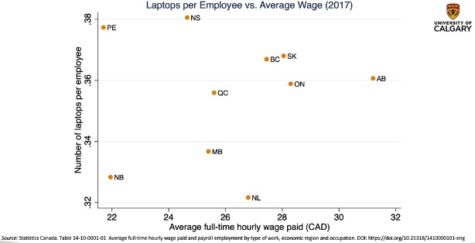
Laptop per Employee vs. Average Wage (Aberdeen, 2017)
“If we exclude the relatively smaller provinces, we do see a positive association,” says Khushboo. She adds that, on average, higher tech intensity is associated with higher hourly wages at the provincial level.

As the Postsecondary Student Information System (PSIS) dataset, it contains detailed information on enrollments and graduates from Canadian public postsecondary institutions. The data includes a variety of metrics such as the field of study, type of diploma obtained, and whether the study was full-time or part-time.

The Canadian Employer Employee Dynamics Database (CEEDD) is where it gets really interesting, says Khushboo. It links employees and employers in the Canadian labor market using individuals’ social insurance numbers and employers’ business numbers. “We can actually track who works where, for how many years, their earnings, and how workers transition from one firm to another over time,” explains the scientist. Additionally, the highly confidential dataset provides data on whether firms are importing or exporting, their profits, tax variables, employee numbers, etc.
Results
The research methodology is based on the assumption that Multinational HQs’ decisions to upgrade their digital technologies prompt similar actions from their Affiliates. Confirming this hypothesis allows the research team to analyze the variations in technological upgrades among Affiliates – variations that are influenced by HQ decisions – to determine their effects on firms and labor market outcomes in Canada.
According to Khushboo, preliminary results show that Multinational Affiliates typically enhance their technological capacities following similar upgrades at their headquarters. These findings are derived exclusively from the Aberdeen dataset.

The outcome variable for both columns is the log of mean storage across sites for Canadian enterprises affiliates of the U.S. multinationals.
Contribution
As Khushboo notes, this study is pioneering in its use of a direct measure of digital technology employed by multinationals that is comparable across countries. This approach enables the estimation of both direct and indirect impacts on workers and firms in the local labor market.
Furthermore, the scientist explains that tracking workers as they transition between local and multinational firms will help identify the mechanisms through which indirect effects may emerge. This analysis will clarify how technological upgrades in multinationals influence digital intensity, employment, productivity, and worker earnings in other firms.
To conclude, Khushboo emphasizes the critical role of the PSIS Data, which the research team has enriched by integrating firm and technology data with workers’ postsecondary education information. ‘This integration offers us a unique opportunity to understand how digital upgrades impact workers with diverse skills and specializations,’ she states. This study not only sheds light on the direct effects of digital technology but also paves the way for further exploration into the broader implications for the labor market.
Ce contenu a été mis à jour le 2024-05-13 à 13 h 53 min.